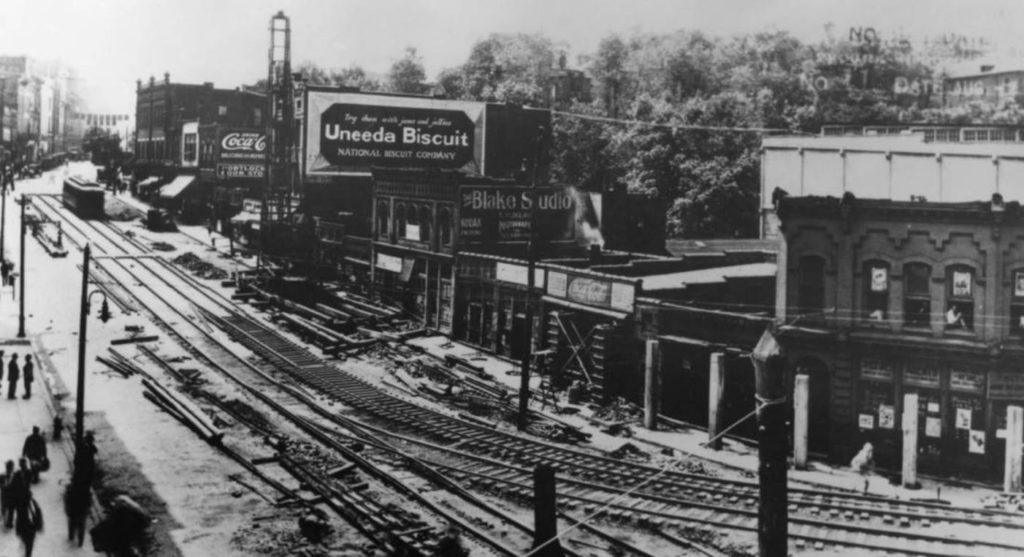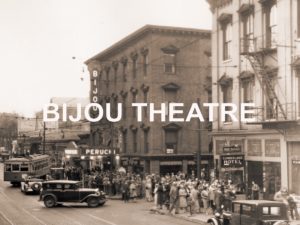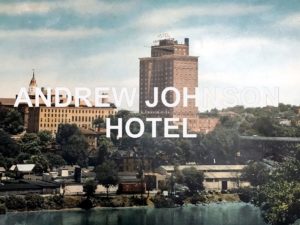Gay Street
Recognized by the American Planning Association as one of the nation’s “Great Streets,” Gay Street was regarded before the Civil War as Knoxville’s main commercial street. The street has hosted hundreds of parades, circuses, holidays, and veterans’ organizations, as well as festivals and civil-rights demonstrations. It’s been home to iconic theaters, hotels, department stores, restaurants and bars, as well as a curious legend about a vengeful white mule.
The street evolved from a muddy track during the city’s fledgling years, raised when it was paved in the 1850s, and later modified to accommodate electric streetcars and of course now daily traversed by thousands of motorists, as well as pedestrians living, working, or simply visiting this vibrant city.

In 1882, the street witnessed a bloody three-way gun fight, the fatal finale to a growing feud between Thomas O’Conner and Gen. Joseph Mabry and his son. Within a couple of minutes of the first gunshot, all three men lay in the gutter, their blood washing away with the morning’s rain. Retold the following year by Mark Twain in his widely read text, Life on the Mississippi, this story is just one of of many told by local author and tour guide Laura Still with Knoxville Walking Tours, a KHP partner. See for The Gunslingers more details.
During the 1920s Gay Street served as a meeting point for a new group of Knoxvillians headed to both discover a new wilderness and blaze trails for a new National Park, the Great Smoky Mountains. The head of the Great Smoky Mountains Conservation Association, Col. David Chapman, also owned a pharmacy business on Gay Street, famous for its White Lion statue.
There are many other stories related to this iconic Knoxville street. Almost everything that has ever happened in downtown Knoxville has a link in some way to Gay Street.
GAY STREET VINTAGE POSTCARD GALLERY
Special thanks to Sam Furrow for digitally sharing his vintage Knoxville postcard collection with KHP through Knoxville Shoebox!
For a look into the 100 Block of South Gay Street by the railroad on the north end of Gay Street, join us for a Knoxville Weekend video featuring KHP’s Jack Neely and Knoxville Urban Guy, Alan Sims, for an affectionate look back at an old classic – Harold’s Deli. This fondly remembered institution was once frequented by musicians such as Flatt & Scruggs and Chet Atkins when they were performing across the street at the old WNOX radio station. Also along that section in the Three Feathers cafe, songwriter and performer Arthur Q. Smith famously sold songs for a few dollars or to simply clear his bar bill.
https://www.knoxvilleweekend.com/knoxville-then-now-harolds-deli/
In 1919, the city raised this section of Gay Street to take out what was known as the “Death Dip,” essentially a steep valley down towards and back up across the railroad tracks. Raising the street level meant that the buildings’ first floors became basements. Those basements became known as “Underground Knoxville” around the beginning of the 1970s.
https://www.knoxvilleweekend.com/knoxville-then-now-100-block-part-1/
https://www.knoxvilleweekend.com/knoxville-then-now-100-block-part-2-of-2/
Taking a short detour just off the 100 block, in another Knoxville Weekend video, Jack Neely takes a stroll along West Jackson Avenue to behind the former Armature Building, where the courtyard there is one of the most interesting and unique spaces downtown.
https://www.knoxvilleweekend.com/knoxville-chronicles-100-block-courtyard/
ROSS MOL’S GAY STREET VIADUCT GALLERY
Photographs in this short gallery were taken by Ross Mol in the early 1970s and he shared them with the Knoxville History Project
through its KNOXVILLE SHOEBOX initiative.
Click on the following icons to jump to related KHP Portal sections!














